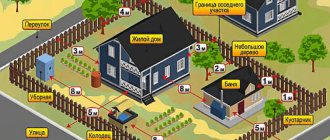The distance from the fence to the road is an important part of residential or country house construction, as well as SNiP standards. It is necessary to know it in order to correctly delineate the landowner’s own territory and the surrounding space. According to the law for 2021, there are different versions of this standard, determined by location, terrain, size and traffic of the route. This greatly complicates the understanding of the issue, since there is no unambiguous standard for the distance from the fence in SNiP or SanPiN.
Garage in the village
Norms and rules: regulatory documents
To correctly determine the distance from the fence of the site to the road, you need to take into account several components at once and check with various legislative documents. It is necessary to familiarize yourself with the Land and Town Planning Codes, SNiP, sanitary and fire safety standards, and only after that, according to legally established standards, you can begin constructing a fence.
The main guideline for the landowner can be a plan of the boundaries of the site, which clearly indicates the possible limits of construction.
The fence should not protrude beyond the limits indicated on the plan.
Near the dacha
You should also consider:
- To prevent the owner from putting forward his own incompetence as an argument, the designated demarcation is tied to noticeable landmarks on the ground or coordinates shown by measuring instruments.
- Documented right to land gives the owner grounds to build a fence on his territory. However, the main condition of the Land and Town Planning Code is the absence of obstacles and inconvenience to the passage and passage of other people.
- There is an approved General Plan for construction in a populated area or in SNT, regulating the required setback that must be observed. The distance from the road to the fence of a private residential building or construction site in this official document ties the boundaries of the site to the red lines, thereby determining the required distance.
- In addition to SNiP, in which you can only find figures for distances from the road to a residential building and buildings, there are fire safety standards and SanPiN, the purpose of which is to protect the health of people living on the site.
- Compliance with SNiP is achieved by observing the standard distances, namely: from a private house to the enclosing structure, and by distancing, in accordance with existing rules, from residential buildings to the flow of cars passing by.
- The main reference point is the road: its size, width, traffic flow, liveliness and air pollution, which is present at certain dimensions and capacity. Whether the road is simply a passage on which traffic is not constant, or a busy multi-lane highway - this is the main condition, taking into account which the required distance is determined.
Near the cottage village
The land surveying of SNT common lands can be divided into several stages:
- Contacting government agencies authorities for permission. Before this, the chairman of the SNT must convene a general meeting to agree on the surveying of the public territory of the SNT, since the costs of surveying fall on the members of the partnership and directly affect their interests.
- Cadastral works. To prepare a project, you should contact a specialized organization that prepares a project for planning and land surveying, based on available documentation and measurements.
- When a territory planning project is developed and prepared, it must go through the approval procedure by local administration authorities.
- Registration in Rosreestr. A package of land surveying documents is submitted for registration, as a rule, through the MFC, then Rosreestr authorities check the legality of the information and register the SNT for cadastral registration.
How many meters from the road should the fence be?
The legal side of deciding where to install depends on the concepts of “road” and “roadway”, which in judicial practice are subject to a clear distinction:
- the road can reach a distance between curbs of 3.5 m, while it has both curbs and a sidewalk (in other documents - a pedestrian zone);
- the roadway (a place for the movement of vehicles that do not have shoulders) is established by the General Plan and territorial regulations regulated by decrees of local authorities;
- a passage is just a segment connecting parallel streets; ideally, the distance between its edges should be at least 3 m (so that a walking pedestrian does not get hurt when a car passes).
Oddly enough, other standards registered in official documents that have legislative status since 2010 are of primary importance in determining the distance between the fence and the roadway.
Previously, in the era of state standardization and GOST, strict adherence to them was a reliable guarantee that the necessary fire safety and sanitary standards were being met.
Location of buildings in SNT and individual housing construction according to SanPiN
A fence in SNT or on the territory of individual housing construction can and should be placed clearly along the border of the site indicated on the general plan of the land plot. It is also possible to move the fence deeper into the owner’s territory, but it cannot be placed behind it. This will be regarded as a violation and land grab.
Purposes of establishing PDO boundaries
The main goals of conducting land surveying of public lands included in the SNT territory are the following :
- Clarification of the boundaries of the plots, their area, as well as the configuration of the plots;
- Reducing the risk of disputes arising regarding adjacent borders with neighbors or accusations of self-seizure of territory;
- Ensuring the possibility of obtaining documents confirming ownership;
- Protection of the rights of the owner in the event that illegal actions are noticed regarding the land in terms of encroachment on his property;
- The possibility of legally increasing the area of the allotment by adding additional territories that do not have their own owner;
- Obtaining a construction permit using a simplified scheme.
What distance should be between neighbors’ fences: for the village and SNT - Fence to the yard
Issues of land surveying, planting green spaces, erecting houses, fences and other buildings are relevant for all owners of land plots - household or country houses.
Despite the fact that all the norms relating to these points are prescribed by law, some of them are only advisory in nature. Especially when it comes to the distance between neighbors’ fences or from your own fence to neighboring buildings.
What SNiP says
The erection of fences and the distance between them are not regulated. However, there are standards that determine the distance from the border of the site to buildings. And since fences are almost always built along the border of a site, these regulations can also be applied to such fences.
The basic sanitary standards for distance from the fence ( SNiP 30-02-97 ) establish the following minimum distances:
- between the fence and the house on your own and neighboring plots - 3 m, with measurements taken from the base to the boundary;
- from the fence to any technical building (bathhouse, garage) located on your own and neighboring plots - 1 m;
- from the fence to outbuildings intended for poultry houses and keeping pets - 4 m.
In addition, there are regulatory requirements for the minimum distance of the fence from green spaces:
- from a tall tree – 4 m;
- from an average tree – 2 m;
- from bushes – 1 m.
To ensure that problems and misunderstandings are avoided, it is recommended that you familiarize yourself in advance with the requirements approved by local authorities - they are always based on SNiP, but may vary slightly depending on the region.
What should be the distance between neighbors' fences?
In most cases, to separate two adjacent plots, one fence is sufficient , built in accordance with all the recommendations described above and in compliance with the approved distances to all residential and commercial buildings located on two plots.
Two fences are required if there is a road between the plots. With this option, it is allowed to erect a blind fence between neighbors, while blind fences can be created directly between two plots only with the mutual consent of the neighbors and with the permission of representatives of local authorities.
According to land use rules, if the distance from the fence to buildings is violated (according to SNiP), administrative liability in the form of fines and forced dismantling of the erected fence is possible.
General requirements for installing fences
The fence can be temporary or permanent. The temporary fence is easy to install and just as easy to remove. The simplest example of such a fence is metal pins or pipes driven around the perimeter, to which a chain-link mesh is attached.
In case of disputes, such a structure is quickly dismantled, moved and installed in a new location. Another advantage of a temporary fence is that less stringent requirements apply to such a structure than to a permanent one.
Although it can stand in this form for more than one year.
The permanent fence must go strictly along the boundary. It is designed to last for a long time and is priced accordingly.
Therefore, all legal issues must be resolved before installing such a permanent fence.
There are several general requirements for permanent fences:
- installation is carried out on reliable supports that provide the fence with resistance to gusts of wind, flows of rain and melt water, as well as to the load from its own weight;
- the fence should not obscure buildings and green spaces;
- the fence must have an aesthetic appearance on both sides;
- Solid (solid) fences are allowed to be erected only on the street side.
Another controlled parameter is the height of the fence between sections . The requirements for it differ significantly from the requirements for a fence facing the street. In the second case, there are no strict regulations, except that objects dangerous to others (for example, barbed wire) must be located at a height of at least 1.9 m.
In relation to fences between sections, SNiPs put forward more specific requirements: their height cannot exceed one meter. Since it cannot be deaf, the best option is a chain-link mesh, picket fence or plank fence with gaps between the slats.
A dacha plot is allowed to be surrounded exclusively by a non-solid fence with a height of up to 1 m or a fence in the form of a hedge. In this case, we are talking about the entire perimeter of the site - the side facing the street does not have any advantages.
Distance between fence and buildings
Between the fence and all buildings in neighboring areas, the distances approved in SNiP must be observed. It is necessary to understand that these are forced measures and each parameter is determined by specific factors. For example, there must be a space of at least 3 m between the house and the fence.
The reason is the arrangement of a blind area from the house, which will not be possible if the fence is adjacent closely. In addition, fire and technical safety factors are important.
You also need to know one more tightening.
If a porch, canopy, roof slope, wall fragment and any other architectural forms protrude from the overall structure of the building by more than 50 cm, then all specified distances are calculated from them. In addition, even if you step back 1 meter from the boundary, when erecting the slope of the barn roof, you must direct it in your direction.
These standards apply equally to buildings in both adjacent territories.
In any case, the legislative documents that regulate the installation of fences between areas call for common sense. They are advisory in nature, but the rules of cohabitation should be understood and followed. After all, you need to live peacefully with your neighbors and not argue even over the most expensive fence - it’s not worth it.
Source:
Distance between areas: standards for borders, fences, driveways and roads
In our country there are a large number of rules and regulations that regulate construction issues and require strict compliance.
When a landowner receives permission to build a private house, these requirements must be taken into account and all indents are provided. But often houses are registered retroactively.
//www.youtube.com/watch?v=xO498Xk17Ew
If it was built with violations, then it will have to be registered through the court.
To protect yourself from controversial situations with neighbors and problems related to land management issues, you need to know the basic requirements.
Land plots: regulations and red lines
Building codes and regulations in our country were first adopted in 1955 and have been modified several times since then:
- SP 42. 13330. 2011 - The document is an updated version of SNiP 2.07.01-89 and is directly related to the construction of residential buildings;
- A similar set of rules is SP 53.13330. 2011 is also available for the development of summer cottages.
Before you begin any type of construction work on your site, you need to decide on the red line separating your territory from the public one. This is extremely important, since any building that goes beyond this line can be demolished by court order.
Red lines serve to mark the boundaries of territories and separate land plots from such structures as:
- electrical lines;
- main gas pipelines;
- wired communication lines;
- roads and railways.
The red line on the site makes its own amendments to the construction conditions. A residential building can be built no closer than 5 m from it, and tall trees should be located at a distance of no closer than 4 m. They should not impede the passage of special vehicles and fire fighting equipment, or worsen the required illumination of buildings.
Consequences of land squatting
In addition to disagreements with neighbors, non-compliance with the planning rules for the location of the site, in particular, the deliberate or unintentional seizure of someone else's territory, can lead to the following very unpleasant consequences:
- If land owned by municipal authorities is seized, a fine will be collected from the person who violated the law. This can happen, for example, if a fence has captured a piece of land that was not included in the master plan and is located closer to the road than the norms allow;
- Sometimes it happens that communication lines are laid under the captured land. If problems occur and there is a need to repair the network, it is customary to demolish the structures and objects located in the territory under which the networks are laid. As for the fence, it can be demolished either completely or partially. What can the owner do in this case? Unfortunately, according to the law, he does not have the right to make claims for damages, since he himself is responsible for the illegal construction of the fence.
The number of meters of distance between objects and roads (street, pedestrian sidewalk) that must be taken into account to build a house
Expansion of land area
What should the owner do if he has a desire to expand his territorial possessions? To do this, he should contact the administrative body of his locality with a written application. The application must indicate the intention to purchase the territory of the desired area.
The application may be approved or rejected. If it has been approved by the authorities, payment for all material resources for registration will be the responsibility of the owner. An application may be rejected, for example, if changing the location of the fence would impede the movement of vehicles or cause any discomfort to the population.
Another option to realize your desire to buy a plot of land is to contact a realtor specializing in these services. This procedure is faster than the previous option, but the customer of real estate services will have to pay a significantly larger amount.











